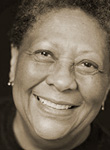Welcome to Blackbird’s In Previous Issues. Here we call your attention to work in our archives that for one reason or another has particular resonance against the work being newly published and/or the moment in which we are publishing. In addition, we will recognize work by old friends who are also current contributors and significant book-length material that we believe deserves steady and ongoing attention.
The fifth annual Claudia Emerson Reading Loop primarily features Leslie Shiel’s close reading of Emerson’s poem “On Leaving the Body to Science,” which was originally published in Claude Before Time and Space, the last of her carefully constructed books. The text of a commencement address from Virginia Commonwealth University in 2014, snapshots from Emerson’s family and adult life, and the previously unpublished poem “The Bookmobile Lady: Pittsylvania County, Virginia,” also appear in the loop. The unfinished “Eschatologies,” published in v18n1’s loop and examined by Lena Moses-Schmitt, can be fruitfully read against “On Leaving the Body to Science,” as Emerson seems to juxtapose her body’s own failing against our failure to preserve the natural world: both are wilting, like the “hothouse flowers / someone brings . . . // in a sleeve / of plastic a tent / where they cannot breathe.” Blackbird’s relationship with Claudia Emerson’s work began in v1n2 with a review of Pinion, her second book. Four poems from the Pulitzer Prize–winning collection Late Wife appeared in v2n1. Other of her Blackbird appearances include the title poems for Secure the Shadow in v9n1 and The Opposite House in v12n1.
Susan Aizenberg first appeared in Blackbird v2n2 as the winner of the Levis Reading Prize for her poetry collection Muse. Aizenberg frequently will employ both narrative and meditation to interrogate memory in poems that marry the connecting tissue of language to music and subject matter. This marriage can startle us into paying attention in fresh ways. Here is a wooden cuckoo from v3n2: “Each hour I hear it crow, bright cry rising from its mechanical throat like the freed breath of sleepers.” Aizenberg’s work also appears in v12n2, and she is represented in this issue by three poems, “After Reading the News this Morning . . . ,” “Eleanor Remembers Her Soldier,” and “Now That You’re Nowhere.”
Carol Ann Davis first appeared in Blackbird’s v9n1 with her poem “After Lorca” and was represented in v14n1 by a nonfiction piece, “Failing Big: What Elizabeth Bishop Teaches Poets about the Twofold ‘Never Again’ of Emotion and Craft.” The essay is a welcoming one, and Davis concludes by telling us that “Back at my blank page, or better, back at my messy, failed, ridiculously essay-like or rhetorical page, I’m far from a nearly finished poem waiting for a word on a bulletin board, but maybe I’m closer to some ‘never again.’ I have an impulse toward difficulty and dread, toward staying near it and coaxing it with limited language.” Our current issue features three new poems from Davis: “From this blue born,” “Looking for God (its big machine),” and “What is the layer.”
Three poems by Jennifer Franklin appeared in Blackbird’s v16n1 issue: “Amor Fati,” “Lavinia, Afterwards,” and “Philomela After the Metamorphosis.” Her poems frequently interrogate the grief fused to her love for her autistic daughter, and she uses myth and lyric as a route to that questioning. As she notes in The Chapbook Interview in 2014, “As much as I try to imagine the lives and emotions of others (I am a fan of reading and writing persona poems) I did not want to imagine her interior world. . . . My beliefs on the power of lyric poetry are similar to those of Gregory Orr, as he presents them in the critical work Poetry as Survival. Lyric poetry contains an abiding power to transform deep experience into something transcendent.” This issue features four new poems from Franklin: “Annunciation, without Angel,” “June,” “Reading About The Lost Children of Tuam,” and “Still Life with Gold.”
As an artist recognized for her mastery of the short story by the PEM/Malamud Award, Amina Gautier relies on a grab bag of techniques and tropes examined and employed over a long practice to provide resonance for characters who often operate within severely restricted elements of space and time. In a 2012 interview in pif Magazine, she says of her own attraction to the form: “Long before I started writing, I consumed stories the way a kid consumes potato chips; I couldn’t just read one. I loved the way the setting in Katherine Mansfield’s ‘Bliss’ revealed more about Bertha Young than her dialogue did. I appreciated the attention to detail in James Joyce’s Dubliners. I saw the way Toni Cade Bambara invoked the streets of Harlem—public parks and fire hydrants and all—in her stories.” Blackbird published Amina Gautier’s “Childhood Princesshood, Motherhood” in v16n1 and her story “Hungry, Like the Wolf” in v18n1. The v19n1 issue features two new Gautier stories: “Dutch” and “Everything.”
Blackbird has published two full-length books and is in the process of publishing two more.
Early on, Blackbird presented the entirety of Norman Dubie’s The Spirit Tablets at Goa Lake, a book-length futurist poem. The poem was issued serially in three parts, beginning with the “Book of the Jewel Worm” in v1n2. It was followed by the other two sections, “Book of the Jaspers” and “The Book of Crying Kanglings,” in v2n1 and v2n2, as well as a helpful introduction and glossary. As Dubie states in a note to the piece, “This futurist poem enjoys the broken narration of its hero, Paul Ekajati, an amateur mathematician who once taught the Calculus on our moon. He is now an exhausted buddhist Vajramaster living in a small village at the Bakavi Lake Mining Colony on Mars. The year is 2277. Yeshe Khandro is in her last black ovum. Or, I should say that a raised mischievous voice in the poem belongs to a dakini ‘wisdom traveler in space’ and that she is the destroyer of the Vega Remnant, LXT. There are eleven spirit tablets.”
Nobel Prize–winning author Tomas Tranströmer’s 1996 book Sorgegond olen (Sorrow Gondola), in a new translation by Patty Crane and accompanied by the original Swedish, was published in Blackbird v10n1. To accompany the new translation Jean Valentine provided a letter to the Nobel laureate and David Wojahn presented a compelling meditation on literary friendship and correspondence in “Unlikely Magic, (on Airmail: The Letters of Robert Bly and Tomas Tranströmer).” There, Wojahn states, “The great subject of the poetry of Tomas Tranströmer—sometimes it seems as though it is his only subject—is liminality. He is a poet almost helplessly drawn to enter and inhabit those in-between states that form the borderlines between waking and sleeping, the conscious and the unconscious, ecstasy and terror, the public self and the interior self. Again and again his poems allude to border checkpoints, boundaries, crossroads: they teeter upon thresholds of every sort—be they the brink of sleep or the brink of death, a door about to open or a door about to close.” In this issue, Blackbird highlights six new Crane translations of Tranströmer poems.
Since Wesley Gibson’s death in December 2016, Blackbird has contemplated ways to ensure his literary voice maintains a presence in the world. With that end in mind, we are in the process of reproducing his book, You Are Here: A Memoir of Arrival, which was published in 2004 by Back Bay Books. The book, in part, is an account of Gibson’s witness to the HIV/AIDS crisis and its beginnings in New York City. Hailed at the time by Mary Gaitskill as “dark and sparkling, wonderfully intelligent, flip, and deeply felt,” You Are Here affords an excellent vehicle for honoring Gibson’s many strengths as a writer and his generosity of spirit as a friend. The first installment appeared in v17n1, with the next two appearing in v18n1 and v18n2. A review of You are Here and a reading by Gibson were published in v3n1. His story, “The Raccoon,” appeared in v10n2.
Marilyn Nelson has for many years celebrated her friendship with Danish writer Inge Pedersen by translating her work, thus making it more available to the Anglophone world. Nelson’s translations of poems from Pedersen’s Den trettende måned appeared in Blackbird v1n1. Her translation of “Clouds and Fire Engines,” an excerpt from Pedersen’s last novel, The Path Leads through the Air, appears in v18n1, followed by another excerpt “The Apple” which appears in v18n2. In this issue, Blackbird continues the story with “Seedlings.” Nelson herself is the author and translator of more than twenty books of poetry for both children and adults. ![]()









